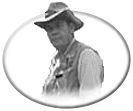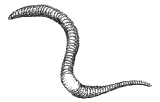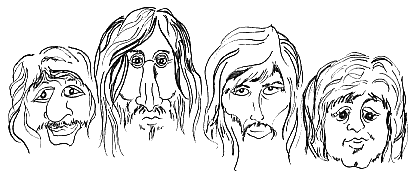 Terrestrials Terrestrials
article
by Ron Newman
Drawings by Barb Krimmer & Ron Newman
The
terrestrials may have aquatic relatives but none intentionally
spent any of their life cycles in the water. Bees and wasps, houseflies,
butterflies, caterpillars, spiders and so on are not important
to the trout except for those that occasionally fall into the
water. These 'land' bugs comprise less than 1% of the food consumed
by the trout during a season. However, on occasion they are what
the fish are after. The following is a quick look at the more
common or important terrestrials you may encounter on our interior
lakes.
 Flying
Ants: Flying
Ants:
If
you are interested in looking up more information, Ants belong
to the order of Hymenoptera. Like Bees, ants work cooperatively
in a community union, and like bees, this relationship of community
to individual is not fully understood. Ants are not aquatic creatures
but many of the 'flying ants' end their days by accidentally landing
in a lake or stream.
The
queen ant lays her eggs and those are nurtured to become a queen,
worker, soldier or drone. Unfertilized eggs become female and
these include the future queens, and any workers or soldiers.
What they become depends on how they are fed by the colony. Any
fertilized eggs become a drone or fertile male. When a colony
is successful, the queen will lay a batch of fertilized eggs along
with batch of unfertilized eggs. These are specially tended by
the worker ants, go through a pupa stage and develop wings for
flight. They are the fertile male drones and future queens of
new colonies. These are the flying ants that you see landing in
the lakes.
Several
colonies often hatch these winged adults at about the same time
for mating flights. After the mating flight, the males will shortly
die. However, the fertilized females will go on to become queens,
lay eggs and establish new colonies. The single fertilization
during the mating flight will be stored in a sac within the queen
to produce males whenever they are wanted. During these mating
flights, both the winged male and female will become exhausted
and fall into lakes and streams. With about 14,000 species of
ants, these "hatches" are quite variable in terms of an individuals
size, color, or timing of hatch.
I
have seen flying ant hatches occurring from late April through
late September. The ants seem to hatch their flying offspring
when the weather conditions are just right. The type of ants range
from the small reds to the large black Carpenter Ants. The Carpenter
Ants seem to be the most frequently observed and are most abundant
through April, May and June. The small red ants tend to hatch
near the end of July through early August. From late August through
September, a medium sized brownish-red ant is hatching that could
be mistaken for a terrestrial beetle unless closely examined (very
fat and plump).
Fishing
Tip
 When
the fish are feeding on flying ants it is usually on the surface.
Try dry flies that resemble the shape, size and color of the flying
ant hatch. An excellent imitation is a fly that is tied with cellophane
wings. Although it is a good imitation, it doesn't cast well,
but it will catch fish. If you can get a pattern with cellophane
wings (or similar) which casts well and floats, it should be a
winner. When
the fish are feeding on flying ants it is usually on the surface.
Try dry flies that resemble the shape, size and color of the flying
ant hatch. An excellent imitation is a fly that is tied with cellophane
wings. Although it is a good imitation, it doesn't cast well,
but it will catch fish. If you can get a pattern with cellophane
wings (or similar) which casts well and floats, it should be a
winner.
 Grasshoppers
& Crickets: Grasshoppers
& Crickets:
These
belong to the order of Orthoptera if you want to find more information.
Cockroaches, mantis and walking sticks also belong to this order.
There are over 10,000 species of Orthoptera in the world. BC has
a reasonable share of these. Like most terrestrial bugs, these
sometimes find their way into our water systems where trout and
other fish readily utilize them as a food source. Grasshoppers
(goppers) seem to find their way into our water systems much more
frequently than crickets but both can be considered as a favored
food source.
Goppers
and crickets lay their eggs in the late summer or early fall and
then die. The eggs are usually laid in holes burrowed into the
ground. These eggs over-winter and hatch in the spring. This usually
starts in early June in the BC Interior. The newly hatched look
much like small versions of the adult. They go through about five
in-stars or molts before becoming adult. Most species have wings
but some are only able to 'hop' with their well-developed hind
legs.
 Those
goppers or crickets that fly are more likely to become a meal
for the trout than the hopping variety. Those, which fly, are
more apt to land in the deeper water. Those that hop land near
shore and often reach land before a trout considers them worth
eating. For the same reasons, goppers and crickets are more likely
to become a food source on rivers or streams than on our lakes
because they get swept into the current and deeper water. Those
goppers or crickets that fly are more likely to become a meal
for the trout than the hopping variety. Those, which fly, are
more apt to land in the deeper water. Those that hop land near
shore and often reach land before a trout considers them worth
eating. For the same reasons, goppers and crickets are more likely
to become a food source on rivers or streams than on our lakes
because they get swept into the current and deeper water.
Fishing
Tip
Try
fishing a dry-fly grasshopper imitation from early July to late
August on our rivers. During the "hot months" the lake fishing
is known to be slow. At precisely that same time the goppers are
in their prime. Put on a pair of shorts, floater vest and old
tennis shoes for wading. You are cooler and the fish are more
active in the rivers. A fish of fourteen inches will put up a
much better fight in the cool currents of a river than the still
warm waters of a lake.
Moths
& Butterflies:
 Both
moths and butterflies belong to the order Lipidoptera which means
'scale wings'. If you touch the wings of a moth or butterfly it
will seem that fine dust is left on your finger. This dust is
actually many very fine scales that look much like feathers under
a microscope. The Lipidoptera life cycle is egg, larva (caterpillar),
cased pupa and adult. Both usually feed on flowers and have a
siphon tube for sucking up the flower nectar. Butterflies usually
rest with their wings together and perpendicular over their back.
Moths usually rest with their wings apart and parallel to the
body. Both
moths and butterflies belong to the order Lipidoptera which means
'scale wings'. If you touch the wings of a moth or butterfly it
will seem that fine dust is left on your finger. This dust is
actually many very fine scales that look much like feathers under
a microscope. The Lipidoptera life cycle is egg, larva (caterpillar),
cased pupa and adult. Both usually feed on flowers and have a
siphon tube for sucking up the flower nectar. Butterflies usually
rest with their wings together and perpendicular over their back.
Moths usually rest with their wings apart and parallel to the
body.
Both
moths and butterflies will occasionally fall into the waters of
our lakes. Butterflies have much broader wings and brighter colors
than moths and are seldom found in the feeding samples. I have
sometimes seen very small fish nibble off the legs of a butterfly
but little more than that. Moths on the other hand look very much
like a Caddis. Both the trout and the fly fisher can easily mistake
them. On close examination the fly fisher will see the scales
on the wings and the siphon tube for feeding. The caddis doesn't
have these. If a moth is unlucky enough to fall in the water during
a Caddis hatch the trout will likely eat it. The best advice for
the fly fisher is to just fish your normal Caddis patterns if
you see moths being taken on the lake.
 Spiders,
Bees, Etc. Spiders,
Bees, Etc.
Spiders,
bees, wasps, and various other terrestrials will fall into the
lake and occasionally be taken by the trout. I can't say that
I have ever actually seen a spider, bee or wasp in a feeding sample
or know a fly fisher that actively ties a fly to imitate these.
However, when food is scarce, the trout will feed on most anything
that offers protein and a few things that don't.
 Terrestrial
Beetles Terrestrial
Beetles
Beetles
come in both terrestrial and aquatic species. All belong to the
order Coleoptera and there are more types of beetles than you
would want to count. About 20% of all animal species on earth
belong to Coleoptera. The aquatic forms of these are discussed
with the section on other aquatic critters. Due to the tremendous
variety of terrestrial beetles and their life cycles I will not
discuss them here. Enough said that most go through the egg, larva,
pupa and adult stages. Many of the terrestrial beetles are able
to fly and thus fall into our lakes and streams. Often you will
see Ladybugs, Bark Beetles, Ground Beetles and other types on
the water surface. Trout will sometimes feed on these if other
food sources are not readily available. The best advice for the
fly fisher is to observe and imitate. Almost any color or size
is possible
Extra
Terrestrial Beatles

Be
sure to read other articles by Ron
Newman
Study
Other Insects
| Tip &
Techniques |
Study Fly Patterns
|



 Terrestrials
Terrestrials Flying
Ants:
Flying
Ants:  When
the fish are feeding on flying ants it is usually on the surface.
Try dry flies that resemble the shape, size and color of the flying
ant hatch. An excellent imitation is a fly that is tied with cellophane
wings. Although it is a good imitation, it doesn't cast well,
but it will catch fish. If you can get a pattern with cellophane
wings (or similar) which casts well and floats, it should be a
winner.
When
the fish are feeding on flying ants it is usually on the surface.
Try dry flies that resemble the shape, size and color of the flying
ant hatch. An excellent imitation is a fly that is tied with cellophane
wings. Although it is a good imitation, it doesn't cast well,
but it will catch fish. If you can get a pattern with cellophane
wings (or similar) which casts well and floats, it should be a
winner.  Grasshoppers
& Crickets:
Grasshoppers
& Crickets:  Those
goppers or crickets that fly are more likely to become a meal
for the trout than the hopping variety. Those, which fly, are
more apt to land in the deeper water. Those that hop land near
shore and often reach land before a trout considers them worth
eating. For the same reasons, goppers and crickets are more likely
to become a food source on rivers or streams than on our lakes
because they get swept into the current and deeper water.
Those
goppers or crickets that fly are more likely to become a meal
for the trout than the hopping variety. Those, which fly, are
more apt to land in the deeper water. Those that hop land near
shore and often reach land before a trout considers them worth
eating. For the same reasons, goppers and crickets are more likely
to become a food source on rivers or streams than on our lakes
because they get swept into the current and deeper water.  Both
moths and butterflies belong to the order Lipidoptera which means
'scale wings'. If you touch the wings of a moth or butterfly it
will seem that fine dust is left on your finger. This dust is
actually many very fine scales that look much like feathers under
a microscope. The Lipidoptera life cycle is egg, larva (caterpillar),
cased pupa and adult. Both usually feed on flowers and have a
siphon tube for sucking up the flower nectar. Butterflies usually
rest with their wings together and perpendicular over their back.
Moths usually rest with their wings apart and parallel to the
body.
Both
moths and butterflies belong to the order Lipidoptera which means
'scale wings'. If you touch the wings of a moth or butterfly it
will seem that fine dust is left on your finger. This dust is
actually many very fine scales that look much like feathers under
a microscope. The Lipidoptera life cycle is egg, larva (caterpillar),
cased pupa and adult. Both usually feed on flowers and have a
siphon tube for sucking up the flower nectar. Butterflies usually
rest with their wings together and perpendicular over their back.
Moths usually rest with their wings apart and parallel to the
body.  Spiders,
Bees, Etc.
Spiders,
Bees, Etc.  Terrestrial
Beetles
Terrestrial
Beetles 